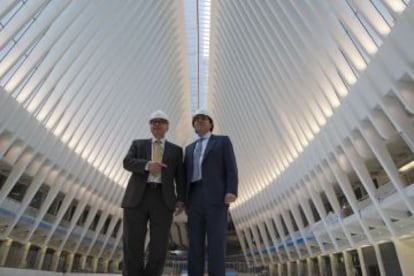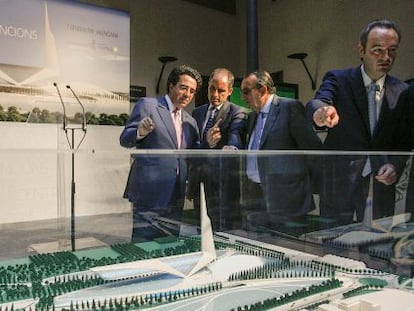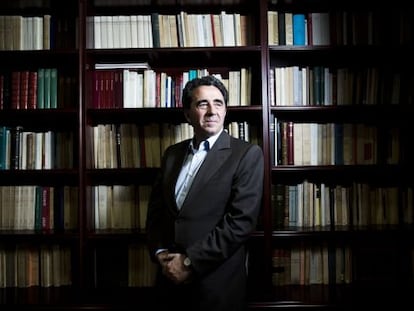Amid little fanfare in Manhattan, Santiago Calatrava’s hub opens
Spanish architect’s Oculus is the most expensive train station ever built

Seven years late and at a cost of almost $4 billion, Santiago Calatrava’s white dove has landed in the space left by the Twin Towers, next to the museum dedicated to the victims of the 9/11 terrorist attacks. The ultra-white structure, which houses a transport hub and vast shopping mall, aspires to join other emblematic buildings in New York, such as Grand Central Station.
Despite the delays and overrun costs, the Oculus is being touted as a powerful symbol of the recovery of lower Manhattan
The World Trade Center Transportation Hub, to give the project its proper name, opened with little fanfare on Thursday. The idea is for an official inauguration nearer the summer, when it is fully operational.
But despite the delays and overrun costs (twice the original budget) of the Oculus, or main hall, it’s being touted as a powerful symbol of the recovery of lower Manhattan. The aim is to greatly improve transport in New York’s booming financial district and provide services for the 200,000 passengers that head for Wall Street and onward to other areas of the city.

Described by its fans as a modern-day cathedral, this vast, light-filled hall covers a warren of passageways and tunnels leading to connections out to New Jersey. To give some idea of the scale of the Oculus, its steel-ribbed walls rise 30 meters into the air, higher than Grand Central Station, which Calatrava says is his favorite building.
“The building is a monument to life: a symbol of the faith in the future of this city, dedicated to its inhabitants, and by extension, to the world,” reads a press release issued by Calatrava’s office. “I hope it becomes a symbol of progress and renewal,” it adds.
The building is a monument to life: a symbol of the faith in the future of this city Press release from Calatrava’s office
Work began in 2004 and was due to finish within five years. It has aroused controversy from the start, and not just because of cost overruns, delays, and technical problems. Many critics argue it jars with the other structures built in the area once occupied by the Twin Towers.

Calatrava believes the station will revitalize lower Manhattan in the same way Grand Central Station and Penn Station did in their time. “It will follow in the footsteps of other iconic structures in the city, such as the bridges that cross the Hudson and the East River,” he says.
The transport hub is the most expensive train station in the world, and has cost more than the One World Trade Center, the tallest building in the western hemisphere. The new head of the New York Port Authority, which owns the land the Oculus is built on, recently described Calatrava’s structure as “a symbol of excess”. It now remains to be seen if as well as extravagant, it turns out to be a good investment.
Tu suscripción se está usando en otro dispositivo
¿Quieres añadir otro usuario a tu suscripción?
Si continúas leyendo en este dispositivo, no se podrá leer en el otro.
FlechaTu suscripción se está usando en otro dispositivo y solo puedes acceder a EL PAÍS desde un dispositivo a la vez.
Si quieres compartir tu cuenta, cambia tu suscripción a la modalidad Premium, así podrás añadir otro usuario. Cada uno accederá con su propia cuenta de email, lo que os permitirá personalizar vuestra experiencia en EL PAÍS.
¿Tienes una suscripción de empresa? Accede aquí para contratar más cuentas.
En el caso de no saber quién está usando tu cuenta, te recomendamos cambiar tu contraseña aquí.
Si decides continuar compartiendo tu cuenta, este mensaje se mostrará en tu dispositivo y en el de la otra persona que está usando tu cuenta de forma indefinida, afectando a tu experiencia de lectura. Puedes consultar aquí los términos y condiciones de la suscripción digital.
More information
Últimas noticias
Most viewed
- Sinaloa Cartel war is taking its toll on Los Chapitos
- Oona Chaplin: ‘I told James Cameron that I was living in a treehouse and starting a permaculture project with a friend’
- Reinhard Genzel, Nobel laureate in physics: ‘One-minute videos will never give you the truth’
- Why the price of coffee has skyrocketed: from Brazilian plantations to specialty coffee houses
- Silver prices are going crazy: This is what’s fueling the rally










































